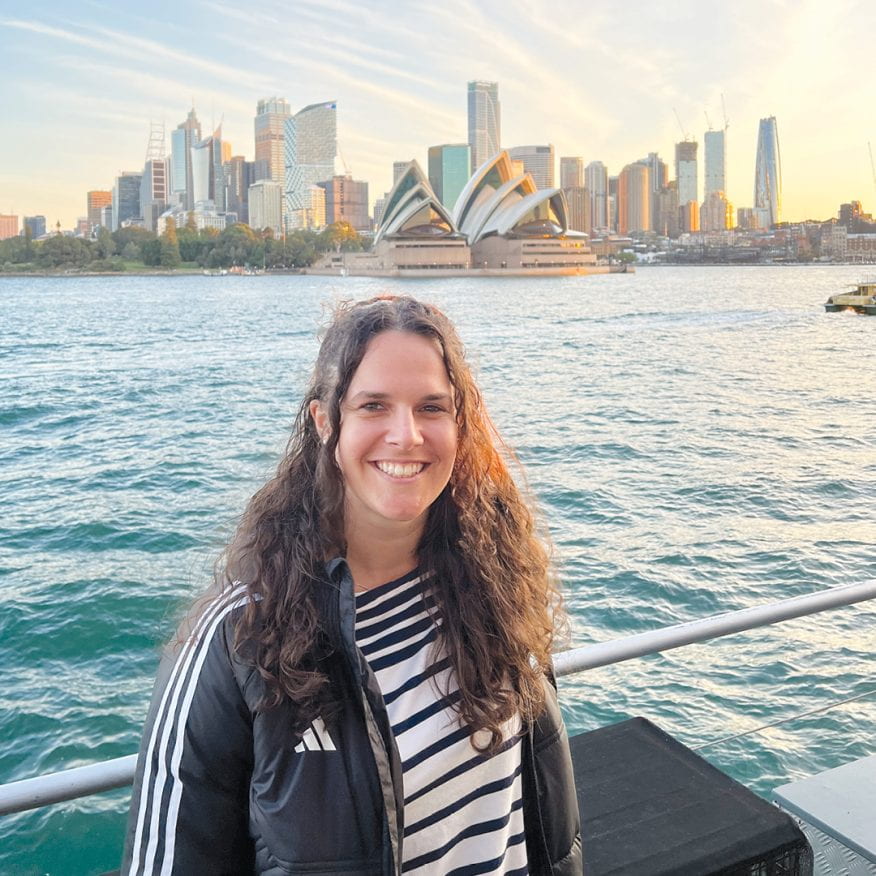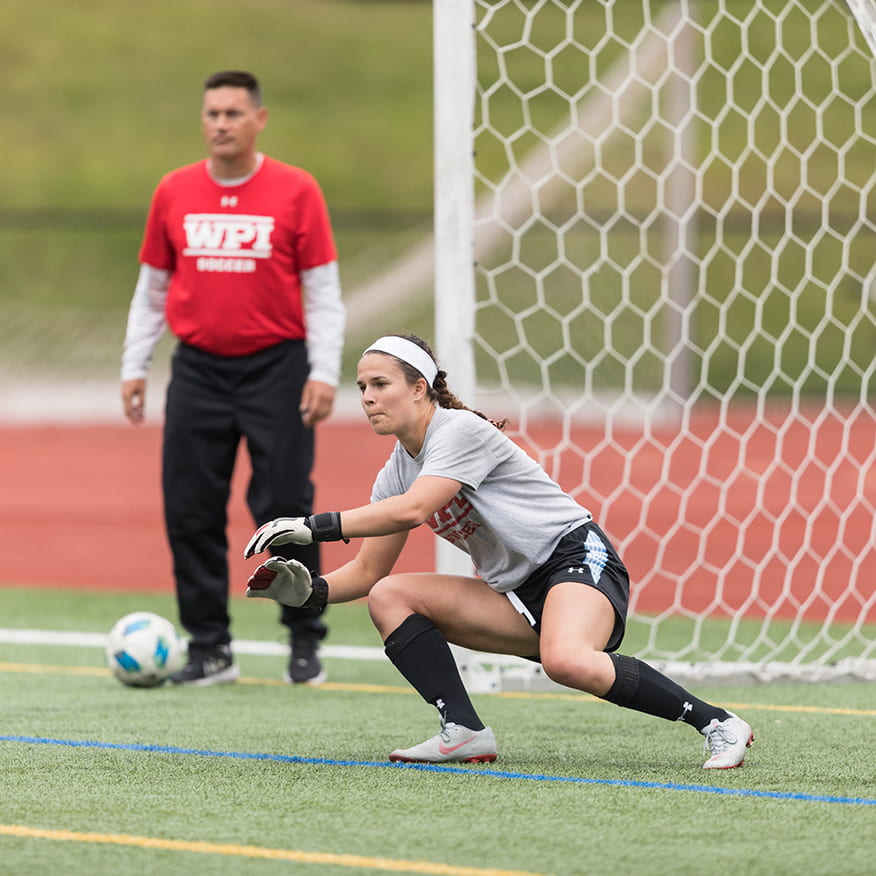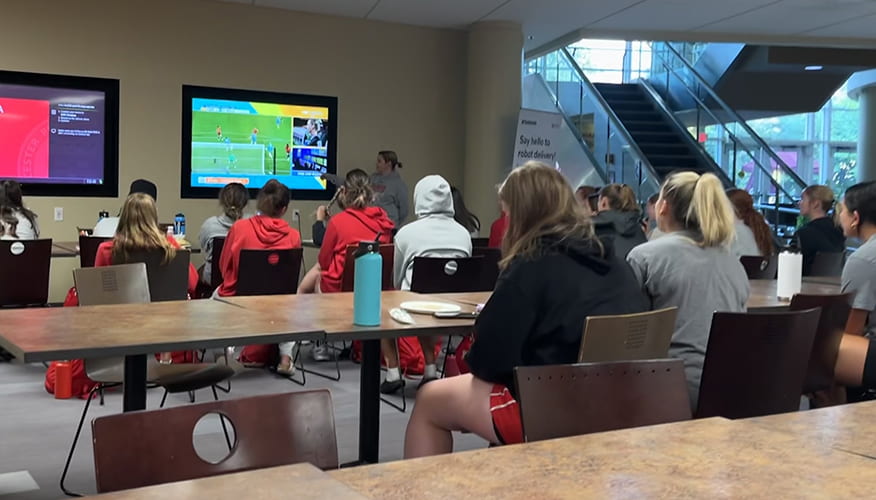It’s Good to Be King
DraftKings co-founder Paul Liberman ’05 builds a gaming empire with an engineering mindset.
Read StoryGabriela Hoops ’19 operates at the crucial intersection between sports and tech.
With the score a stubborn nil-nil, the tension ratcheted up as the match proceeded into overtime. Nigeria and England, competing fiercely to earn a slot in the quarterfinals of the 2023 FIFA Women’s World Cup, would have to shoot it out in a series of penalty kicks.
Athletes from each team alternated attempts: An England miss, then a goal snuck in by Nigeria. The crowd—some 50,000 people filling the largest stadium in Brisbane, Australia—held its collective breath as the kicks continued. Within three dramatic minutes, the score was 4-2 and the crowd went wild. England would advance.
Seated before a bank of monitors at the International Broadcast Compound (IBC) in Sydney, Gabriela Hoops ’19 was watching the match closely. It had been a long day, and she still had a post-match review to complete. There were two weeks—and nine matches—to go before a world champion emerged. But Hoops wouldn’t have chosen to be anywhere else.
“I’ve just always been passionate about soccer,” she says. “It’s one of the few sports that, as a girl, you can imagine growing up to play professionally.”
Making it to the World Cup was always her ultimate dream. And while Hoops may not have been on the field during the tournament in Australia and New Zealand last summer, she did have a key role. As a replay operator with Hawk-Eye Innovations, the world’s top provider of video assistant referee (VAR) technology, she used the firm’s cutting-edge system to help FIFA officials make fair and accurate decisions about goals, offenses, and penalties. The stakes were as high as they get, and Hoops was in her element. For the 2019 mechanical engineering graduate and former WPI soccer goalkeeper, a career with Hawk-Eye offered the perfect combination of sports and technology, bringing together the engineering skills she honed at WPI with a love of the game that has animated her for as long as she can remember.
Hawk-Eye Innovations’ computer vision technology was originally developed by British engineers in 2000 for use in television broadcasts of cricket to help viewers see the ball’s trajectory. The company soon adapted its ball-tracking, smart replay, and other technologies for sports as diverse as golf, ice hockey, and NASCAR. Meanwhile, applications grew to include not only telecast enhancement but officiating. Hawk-Eye now works with the majority of the world’s top leagues and has become a brand recognized by sports fans around the globe.
“A lot of people know us from watching tennis, where you see the ball and its shadow,” Hoops says. “That’s what we do.”
Although the technology can determine locations down to a few millimeters, some leagues were cautious in embracing video review to make officiating decisions. As time went on, the utility of using it for tough calls—for instance, determining the precise location of a ball or a player’s foot relative to a boundary line—became impossible to ignore.
“The more popular sports tend to be entrenched in their ways,” she notes. “But, at the same time, I think players, coaches, and fans would be more upset if it wasn’t used.”

Hoops joined Hawk-Eye’s U.S. headquarters in Atlanta immediately after graduating from WPI. In the summer of 2019, it was a small office (although it would grow by 2023 to more than 70 U.S. employees), and the team was looking for someone who would immediately fit in, says operations manager Laura Harris, who became Hoops’s boss and good friend.
“We really needed someone who would have a great attitude, as well as having great tech knowledge, and she ticked all the boxes,” Harris says. “She blitzed the interview—obviously her experience playing soccer was a big pull. Gabriela’s very passionate about everything she does, which is a huge asset, as is her ability to work well with all different people. She’s very good at organizing herself and organizing others. I’m sure that has a lot to do with her sporting background and working in a team.”
Hoops’s first assignment at Hawk-Eye was to undergo training in the company’s proprietary systems at its European offices, first in France and then in the U.K. Those early weeks set the pace for a job that would involve plenty of travel, as she went on to operate or provide tech support for soccer matches as well as for the National Hockey League, Major League Baseball, and professional golf’s Masters Tournament.
VAR made its international soccer debut in 2016, starting with exhibition matches and the FIFA Club World Cup, one of the international soccer organization’s lower-profile tournaments. It wasn’t long, however, before FIFA wrote video review into its Law of the Game. On-field officials, simply because of their single vantage point, can’t see everything that happens on the field. On the other hand, the dozens of cameras that a Hawk-Eye system taps into can track balls and players from multiple angles, and video assistant referees (the FIFA officials who use VAR technology) are tasked with reviewing decisions to ensure the right call is made.
Hoops’s role in the 2023 Women’s World Cup began before the players arrived. In July she and the Hawk-Eye team flew to Australia for a practice camp with FIFA officials, during which they worked through every element of the game—from fouls to penalty kicks—in a series of on-field simulated matches. Once the tournament was underway, Hoops put in nine-hour days, beginning with reviewing the previous night’s games and all decisions made by officials before she and her team spent several hours setting up for the evening’s match. The highlight of each day was the match itself, a thrilling experience that demanded both skill and composure.
To be able to go to a Women’s World Cup was a dream come true, and I like that I got to be a part of it as more than a spectator.
“You’re not just sitting back and waiting for something to happen,” Hoops says. “There are official checks that you see on TV when the referee runs over to the screen. But the VAR team is checking everything throughout the game. The moments of high pressure are certainly there, and it takes a lot of experience to get used to it.”
In addition to knowing how to operate the system, knowledge of the game itself is crucial, she explains. “You need to know who you’re listening for and what you’re checking. There’s a lot of audio and visual information in this high-pressure situation with not a lot of time to think. But it’s also exciting. To be able to go to a Women’s World Cup was a dream come true, and I like that I got to be a part of it as more than a spectator.”
Hoops can’t actually remember when she first stepped onto the soccer pitch—she may have been 3 or perhaps 4, but it was definitely at the age “when kids’ shirts are too long and you can’t find shorts that fit,” she says with a laugh.
The Connecticut native played through high school and knew she wanted to play in college. She also loved math and science; she wanted to study engineering; and she hoped for the opportunity to study abroad. A few interviews with college coaches helped her narrow her options, but it was only when she met Stephanie Riley-Schafer, WPI’s head coach since 2013, that she knew where she was going to spend the next four years.
“I could do my engineering degree at WPI,” she says, “but I could also play soccer at a high level on a competitive team where I liked the coach, and I could study abroad—and do all that in four years without disrupting my studies. So that was all I needed.”
The school proved to be a perfect fit. Hoops completed her Interactive Qualifying Project in Copenhagen, examining the potential for urban rooftop farming as a way to create a more sustainable food system and mitigate climate change. Project-based learning worked well for someone who was used to being part of a team, and Hoops learned to take a step-by-step approach to solving difficult technical problems—one that has served her well in her career.
“In the technology sector, a lot of what you’re working on is proprietary,” she explains. “There’s no way for me to have been able to learn Hawk-Eye’s tech before I got here. But what I did learn from WPI was ‘This is how you troubleshoot; this is how you approach complex problems. You just take it one step at a time. How does point A get to point B? What are all the little jumps and hops and skips in between?’”
Hoops excelled academically, but her heart stayed on the field, and Riley-Schafer was pleased to see that her own efforts to recruit the young goalkeeper had paid off.
“Gabi was one of, if not the, best goalkeepers to go through our program,” the coach says. “She was very dedicated to the sport and the team and the academics. I think she found a really good balance in WPI.”
During her sophomore year, Hoops helped the team win a New England Women’s and Men’s Athletic Conference championship. As a senior, she got to flex her leadership muscles, taking on the role of team captain.
“She really took the back line under her guidance and was great about giving feedback and helping younger players,” Riley-Schafer says. “Gabi’s one of those people who includes everybody. A lot of our players just want to put their heads down and get the job done, and she would key in on them and recognize their hard work and recognize what really drove them to be successful.”

The season after Hoops graduated, Riley-Schafer recalls, she did an exercise with her players about what makes a great leader. She asked, ‘What qualities did the players seek in a leader and who embodied those qualities for them?’ Some players named world leaders, others historical figures. But the players who had been on the field with Hoops named her.
“She was somebody that really loved the sport, loved the team,” Riley-Schafer says. “I can see her taking that into what she’s doing now.”
During the 2023 Women’s World Cup, Hoops spent seven weeks in Australia, working most of that time—in all, she operated for 15 of the tournament’s 64 matches, including the final, which saw Spain beat England, 1-0, in a match played before 75,000 fans. Back in Worcester, Riley-Schafer and the WPI women’s soccer team were watching together when the coach got a glimpse of a familiar curly-haired head.
“There were moments where they flashed to the VAR room,” Riley-Schafer recalls. “At one point, they flashed to her. I went up to the screen and I pointed at that head and I said, ‘This is one of our alumni!’ And the players were like, ‘What? That’s amazing. How do we get to talk with her?’”
Hoops graduated before any of the current WPI Women’s Soccer Team members arrived, but they were inspired to know someone who had been in their cleats had made it to the World Cup, working at a crucial intersection between sports and tech.

The WPI Women’s Soccer Team watched the 2023 Women’s World Cup to catch a glimpse of Gabi Hoops in the video replay booth.
“I really do think WPI was great for Gabi,” Riley-Schafer says. “I’m glad that she gets to keep sports in her life. And as the years have gone on, hearing where she’s been and what she’s been able to do and all of that, I just think it’s a great fit. Working in sports can be hard. It’s long hours; it’s off hours. So you really do have to love what you’re doing. And I think she does.”
That’s the truth, Hoops says. And while she plans to keep rising through the ranks at Hawk-Eye—she just took on a new role, leading a team on the tech side of the business—the 2023 World Cup will always be a highlight.
“It was really a core memory moment,” she says. “To be involved, at that level, in a World Cup final—that was probably one of the coolest things I’ll ever do in my life.”



Reader Comments
0 Comments